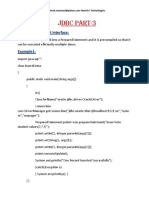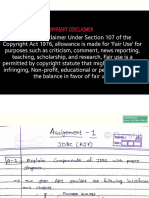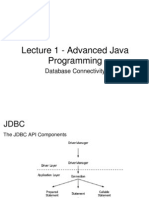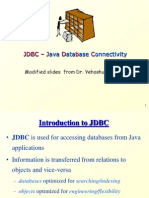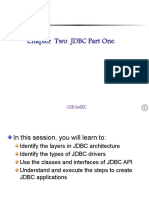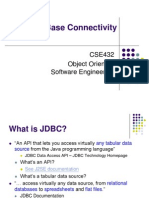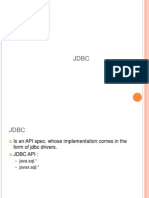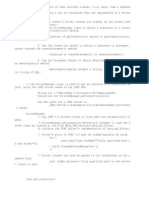0 ratings0% found this document useful (0 votes)
29 views30 pagesJava 2 J2ee
The document provides an overview of JDBC (Java Database Connectivity) concepts, focusing on ResultSet and its methods for accessing query results. It details the types of ResultSets (TYPE_FORWARD_ONLY, TYPE_SCROLL_INSENSITIVE, TYPE_SCROLL_SENSITIVE) and their functionalities, as well as the RowSet interface and its associated Reader/Writer facilities. Key terms related to JDBC and a series of questions for assessment are also included.
Uploaded by
ravindra paliwalCopyright
© © All Rights Reserved
We take content rights seriously. If you suspect this is your content, claim it here.
Available Formats
Download as PDF or read online on Scribd
0 ratings0% found this document useful (0 votes)
29 views30 pagesJava 2 J2ee
The document provides an overview of JDBC (Java Database Connectivity) concepts, focusing on ResultSet and its methods for accessing query results. It details the types of ResultSets (TYPE_FORWARD_ONLY, TYPE_SCROLL_INSENSITIVE, TYPE_SCROLL_SENSITIVE) and their functionalities, as well as the RowSet interface and its associated Reader/Writer facilities. Key terms related to JDBC and a series of questions for assessment are also included.
Uploaded by
ravindra paliwalCopyright
© © All Rights Reserved
We take content rights seriously. If you suspect this is your content, claim it here.
Available Formats
Download as PDF or read online on Scribd
You are on page 1/ 30
JRE Database Concepts 2016- 2018 Batch
— Determines the maximum number of rows a ResultSet may contain
— Unless explicitly set, the number of rows is unlimited (return value of 0)
+ getQueryTimeout/setQueryTimeout
— Specifies the amount of a time a driver will wait for a statement to complete before
throwing a SQLException.
2.13 RESULTSET
ResultSet and Cursors
‘The rows that satis!
y a particular query are called the result set. The number of rows returned in
a result set can be zero or more. A user can a
ss the data in a result set using a cursor one row
at a time from top to bottom. A cursor can be thought of as a pointer to the rows of the result set
that has the ability to keep track of which row is currently being accessed. The IDBC API
supports a cursor to move both forward and backward and also allowing it to move to a specified
row or to a row whose position is relative to another row.
Types of Result Sets
‘The ResultSet interface provides methods for retrieving and manipulating the results of executed
queries, and ResultSet objects can have different functionality and characteristics. These
characteristics are result set type, result set concurrency, and cursor hold ability.
‘The type of a ResultSet object determines the level of its functionality in two areas: the ways in
which the cursor can be manipulated, and how concurrent changes made to the underlying data
source are reflected by the ResultSet object.
‘The sensitivity of the ResultSet object is determined by one of three different ResultSet types:
TYPE_FORWARD_ONLY — the result set is not scrollable ie. the cursor moves only
forward, from before the first row to after the last row.
Prepared by Dr.S.Manju Priya, Department of CS, CA & IT, KAHI Page 19/24
JRE Database Concepts 2016- 2018 Batch
TYPE_SCROLL_INSENSITIVE — the result set is scrollable; its cursor can move both
forward and backward relative to the current position,
and it can move to an absolute position.
cursor can move both forward
VE — the result set is scrollable; its
TYPE_SCROLL_SENST1
and backward relative to the current position, and it can move to an absolute position.
Before you can take advantage of these features, however, you need to create a scrollable
ResultSet object. The following line of code illustrates one way to create a scrollable ResultSet
object:
Statement stmt = con,createStatement(ResultSet. TYPE_SCROLL
ResultSet.CONCUR_READ_ONLY);
SENSITIVE,
ResultSet sts = stmt.executeQuery("
The first argument is one of three constants added to the ResultSet API to indicate the type of a
ResultSet object: TYPE_FORWARD_ONLY, TYPE_SCROLL_INSENSITIVE, and
TYPE_SCROLL_SENSITIVE. The second argument is one of two ResultSet constants for
specifying whether a result set is read-only or updatable: CONCUR_READ_ONLY and
CONCUR__UPDATABLE. If you do not specify any constants for the type and updatability of a
ResultSet object, you will automatically get one that is TYPE_FORWARD_ONLY and
CONCUR_READ_ONLY.
Result Set Methods
‘When a ResultSet object is first created, the cursor is positioned before the first row. To move
the cursor, you can use the following methods:
+ next() - moves the cursor forward one row. Returns true ifthe cursor is now positioned
ona row and false if the cursor is positioned after the last row.
* previous() - moves the cursor backwards one row. Returns true if the cursor is now
positioned on a row and false if the cursor is positioned before the first row.
Prepared by Dr.S.Manju Priya, Department of CS, CA & IT, KAHI Page 20/24
JRE Database Concepts 2016- 2018 Batch
+ first() - moves the cursor to the first row in the ResultSet object. Returns true if the cursor
is now positioned on the first row and false if the ResultSet object does not contain any
rows.
+ last() - moves the cursor to the last row in the ResultSet object. Returns true if the cursor
is now positioned on the last row and false if the ResultSet object does not contain any
rows.
beforeFirst() - positions the cursor at the start of the ResultSet object, before the first row.
If the ResultSet object does not contain any rows, this method has
no effect
% aflerLast() - positions the cursor at the end of the ResultSet object, after the last row. If
the ResultSet object does not contain any rows, this method has no effect.
4 relative(int rows) - moves the cursor relative to its current position.
+ absolute(int n) - positions the cursor on the n-th row of the ResultSet object
2.14 METADATA
RowSetMetaData: This interface, derived from the ResultSetMetaData interface, provides
information about the columns in a RowSet object. An application can use RowSetMetaData
methods to find out how many columns the rowset contains and what kind of data each column
can contain, The RowSetMetaData interface provides methods for setting the information about
columns, but an application would not normally use these methods. When an application calls
the RowSet method execute, the RowSet object will contain a new set of rows, and its
RowSetMetaData object will have been internally updated to contain information about the new
columns.
The Reader/Writer Facility
‘A RowSet object that implements the RowSetInternal interface can call on the RowSetReader
object associated with it to populate itself with data, It can also call on the RowSetWriter object
associated with it to write any changes to its rows back to the data source from which it
originally got the rows, A rowsel that remains connected to its data source does not need to use a
reader and writer because it can simply operate on the data source directly.
Prepared by Dr.S.Manju Priya, Department of CS, CA & IT, KAHI Page 21/24
JRE Database Concepts 2016- 2018 Batch
RowSetInternal: By implementing the RowSetInternal interface, a RowSet object gets access to
its internal state and is able to call on its reader and writer. A rowset keeps track of the values in
its current rows and of the values that immediately preceded the current ones, referred to as the
original values. A rowset also keeps track of (1) the parameters that have been set for its
command and (2) the connection that was passed to it, if any. A rowset uses the RowSetInternal
methods behind the scenes to get access to this information. An application does not normally
invoke these methods directly.
RowSetReader: A disconnected RowSet object that has implemented the RowSetInternal
interface can call on its reader (the RowSetReader object associated with it) to populate it with
data, When an application calls the RowSet.execute method, that method calls on the rowset’s
reader to do much of the work. Implementations can vary widely, but generally a reader makes a
connection to the data source, reads data from the data source and populates the rowset with it,
and closes the connection. A reader may also update the RowSetMetaData object for its rowset
The rowset's internal state is also updated, either by the reader or directly by the method
RowSet execute.
RowSetWriter: A disconnected RowSet object that has implemented the RowSetInternal
interface can call on its writer (the RowSetWriter object associated with it) to write changes back
to the underlying data source.
Implementations may vary widely, but generally, a writer will do the following:
* Make a connection to the data source
* Check to see whether there is a conflict, that is, whether a value that has been changed
in the rowset has also been changed in the data source
‘* Write the new values to the data source if there is no conflict
* Close the connection
‘The RowSet interface may be implemented in any number of ways, and anyone may write an
implementation. Developers are encouraged to use their imaginations in coming up with new
‘ways to use rowsets
SUMMARY
Prepared by Dr.S.Manju Priya, Department of CS, CA & IT, KAHI Page 22/24
JRE Database Concepts 2016- 2018 Batch
‘The JDBC API is a natural Java interface to the basic SQL abstractions and concepts. It builds on
ODBC rather than starting from seratch, so programmers familiar with ODBC will find it very
easy to leam JDBC. An API for database-independent connectivity between the J2EE platform
and a wide range of data sources. The JDBC API supports both models for database access: two-
tier (direct database access) and three-tier (communication with the database over a "middle-tier”
on the database server or a separate machine). The purpose of the JDBC package is to provide
vendor-neutral access to relational databases.
KEY TERMS
© JDBC API: support application to IDBC manager communications
© DBC driver manager: support JDBC manager to driver implementation
‘© IDBC-ODBC bridge: provides JDBC access using ODBC as the communications pipe.
‘© Native API, partly Java Driver: converts JDBC calls directly into calls on the client to the
native database API.
his requires binary code on the client machine.
‘© JDBC Net Driver: translates JDBC into DBMS independent protocol. This independent
protocol is translated by a server into native DBMS calls. Generally deployed using a
middleware server.
‘© Native Protocol - Pure Java: converts JDBC into DBMS native network calls,
QUESTIONS
1 Mark Questions (Multiple choice based)
LA is a collection of dat
afield b. record c. database d. DBMS
2A is a document that defines all components of a database,
aSQL b. database scheme c.table file
3. The JDBC process is divided into routines
a2 b3 4 as
4. The method is used to load the JDBC driver.
a.Class.forName() b, Results.next()
Prepared by Dr.S.Manju Priya, Department of CS, CA & IT, KAHI Page 23/24
JRE Database Concepts 2016- 2018 Batch
System. out printin() d, DB.createStatement()
S.A, i a server side program.
aserviet_b. JSP EB d. Java
6. The uniquely identifies the attribute from other attributes of the same entity.
a.attributename — b. attribute size c.attribute format d.attribute type
1 data stores numbers only.
a Character b. Alpha —_c. Alphanumeric d. Numeric
8. There are methods of the ResultSet object that are used to position the virtual
cursor.
a3 b4 cS a6
9. The method returns the URL of the database.
a. getDatabaseProductName() _ b.getUserName()
c.getURLO 4. getschemas()
10. The is the maximum number of characters required to represent values of the data.
adata name b. data type c. data size . attribute
2 Mark Questions
1. Define Data, Database and Database Schema.
Give a brief notes on different levels of Database Schema.
What is JDBC API?
Write short notes on Statement objects.
ween
List two different packages used in JDBC API
6. List various Resultsets methods.
8 Mark Questions
1. Explain the six steps to create a database schema with suitable examples.
Write a brief note on Normalizing Data with suitable example.
Explain the architecture of JDBC
Describe in Detail four different Types of JDBC Driver.
Explain about Resultsets in Detail.
awa wN
Write a database connectivity program in j2EE for maintaining students detail.
Prepared by Dr.
Manju Priya, Department of CS, CA & IT, KAH Page 24/24
aqqy ainqume. puosar aqqra atdm — |ewep sureyuoo req aseqeyep v Jo jusuodwios v s1 |
wep | swaa prose exep prey. “aun nuove we 04 s1aj0u
saa ager vave swaa Ts &q poBeueu st oseqeiep V
aseqeep | swaa aseqniep proses ‘etep Jo won2oI}00 & 1 ———
soasuy| —_pado endo! zido} Lado suonsand
TLIND
SO?S'W It ssv1D, T0edSO91 AOD Loaranas Tl + Walsads agave: Loaraas
ONAIOS WALAdWOO dO LNAWLUVaA
(spremuo 9102 toy pomnupe sorepypues a4) 404)
120 149 ~ ar0requtt0.)
(9561 9¥ DDN Je € HoNs9S 1apUN PoystgEIsA AUsi9ANIN powseq)
NOILVONGg WaAHOTH IO AWAAVOV
WVOVaaV
ada
onyea uonnyop
somos ainqune | ainqune ainggme aounos angie | yeuuz0y aingune -anyea angus ayy Jo wiSIs0 ayy sayynuap! au.
ad&t | anya uonnyop ‘uoysKs Sunstxo amp wn siwodde
reunroy aynqume | anqune: ainggme azisamqune | reurog anqume fanqume we yom uw Aem om Jo sisisuos oq,
anyea uorunyap adét | anyea uonryop ‘ainqume aq)
ainqume | amqune angume azsamquye | auenanqune {or paudisse BIE FEA
adéi eyep | _amqune ays cep ada eyep aweu erep _ |parersosse erep Jo sonstiaroereys ayy saquasap |
sumer ep | aingeme azys tiep adéa ewep aaen evep fom Jo siuauoduros Buys paretaaiqge aq ues |
“ep ay Arnuapy
aueu ere | amnqune as evep ad&a ewep aweu eyep for ajqyssod se sioroeseys say se axey pinoys —— |
aureu erep | ainqune aais wep adh cep ureu eyep au or nny © aptaoud erep ayy Jo amnyeu oy
“erep amp Jo sanyea yuasaudas oy
wep | _aimqume aais ep 2d rep aureu rep — {paxmbor sioroeseyo Jo soqunu wununtxeus oy) st >
“eep yy Yat
add erep | _amqume ois ee oda eiep aumeu erep _ {porersosse ame reap sonzea Jo pury amp saquosap |
oureu rep | ange ozis rep adi evep oureu Prep aq oy} wong oumu anbym oq
luonreunzoyt
sainqune stwaust409 sanguine sonyea ‘siuauoye erep 0 paanpas aq jsnat
sonqea sonyea sanqume|
siuounuos | ainqume stwounos | _songea pasinbas arqeidesae fae aquosop or past st req) wxoy wHOy aaxg S| |
s s ¢ £ z ssutzoy jeurrou ae ary
‘Avon
ep omsse oy pur mep wepunpas ozrumnm oF sdnoss paras
wonezyeaoN | woneary, undnory wonezteaLION. uonsesuesy fort siomoy> eiep SuzquesI0 Jo ssaoord ayy st
99140 seep Arewig
suraumnueydyy atey | ouaumueydyy rudy aajserey _framo pue ‘soem ‘spray ixay ae, sazoys ep — |
eofoy | _yeai807 sursumueydyy rudy aa 9eI4 ‘o1L10 SoK ~ somyea omy Jo aui0 SaroWs PIED
outyoreg | susumy, awit /area rudy Pe) ‘sonyea oun pue ayep sau01s eIep
ououmy | ououmy | _oysumueydry rudy aaj9RIeYD ‘Aquo szoquma sax01s Prep
‘saoquanr pie
auounueydyy | osumy | _suoumueydty rudy oereyD _|'suoneniound ‘siaroesey> [eonaqeydye soxois rep —_____|
eydiy | owewny | suaunueydiy eudiy aayoerey srarpeieyp jeonaqeyde dquo sai01s erep
‘suonemaumdl
seperyg | oyaumy | syeunueydyy ead zaysereyD _|pue _szaiserey wonoqeydye _sorois_ewep |
AyuBormt | onoge amp Aouapuadop Aouapuadop pojyea st sdnox8}
jarajar_| Jo auON wes Teaonouny _[etep so skoy uByai0y pu er YL
fox ‘uata]9 prep Jo sdnos oan uoansag dayst
Koy uttoroy | uBtar0y Koy Aron Koy Areusrid |e weap 01 past dnost soqouy Jo Kay Arce ¥I
K
Aouapuadap | ouapuadap Aowapuadep ep KaquoN
wey | aarusuen [ewo! Aowrepunpar v
Aouopuadap
awapuodap st eyep Aayuou war
Teaonouny Kouepunpar {se yons ep somo wo spuodap eyep uoyAr sins90 vi
Koy siuatuaya evep|
Koy Kawunad | uBia10y oy renniy oy Aouad opt Ayonbsun yeap yuow|9 wep est |
‘wu jeuzou!
ANE ANY ANE 1 ou
ANZ IN IN € ANI ou
ANI INb INE INL oquore aq 0} woreuZosH ay} Sasmnbas v
anoge aq iqunasse 1815]
sdnos | yoouon sioafqo sdnost ep azttesI0 oy Kea wourtH0D ¥
Owowawe
hsoweoxs-qcr
uownSie ue se Azan
(daandainaaxo Odsondainsaxa_ | Qawensoysse.y | Orxewsninsey four passed st yorum ‘pomtour ayy sureywos yoafgo ywouareIs aK.
£ s t £ z sued Jo ssistoa Tan au
y9olgo Burns v oF SUMS
OSungie8 Qowenzoysse( [aq Jo mor yuaxna ayy uF uuMIos paryfoads e Jo anyer am
Odung323 Qasoraa. Onxaursyinsoy [kdoa o} pasn st yoafgo iaguinsey ayy Jo powpaur au
(nee
‘woreagorea saauuere-wauroqes
Oasorrrqa_ | soeauu03 (ssorsracr Orowsynsoy | Qawenuoy'ssei5 fom ayourumar oy _poyies st pompous ayy,
Omauiar | warrsara | Quonoauuosn
vigawaiepauues | syauueg | ai aseuepuasig Qawenoy sso
90{go quowoyms # aywox9 0} pasn st poxjaus au
Quonsamos) | Orouae | Quonsomo>:
sfusteurpioaug | gowarrga [aS uodeuepyosuC, awenoysse) -aseqeiep axp aouarayor 0} ssaooud axp ynoynomp poss}
s{ vey) aoepIa}uT onDaUUOD w sua poyou ————— ay
Oweware 0
seraioga. |upuud-nownskg (awenoy'sse
(aureysoy'sse1 Orxow'synsoy SOALEP ETAT 248 PeOT 91 pasn st poyyous ————— ay.
s s b € z sounnos out papap st ssao0ud ar aU.
t s t € z SIOALIP J¢qAr Jo soda aw ary
MOMOTEISOTETTED
‘Suyssoooud soypiny 109
lojqnuea 40 yoalqo wonda|joo wart v OnE TOgIASIY oH WO IEP
ragunsey_| aguas wauiarersparedaid wauiayers _|édoo oF pasn are req) spomaur supestios 199[q0 41
wowiosmisparedasd wwouarelsarqeyyes 1090
ragyinsey awotmorersporedard awomoyers fog Suysn_pamnaaxa pue parduroard oq avs Aronb TOS V
ppoyidasoa Azan)
quawarersarqeyre> lay Suieq Isp nog Azanb e aynsaxe Ajareypaumusy oF spaau
wawarers | iagunsoy, awowarersporedaid quawayeys _fuauodwios gaz e seaauay pasn st ysafgo ~~ au
ange ay Aad 2MN Aq passaooidampaaord parors ay} 01 passed
NI_|_soouon LAONI no NI_[>q 01 spoou wey evep Aue surequos rayouresed —— oq
ainpasoad paoys & Buyyeo ay sayauuesed|
€ s b € z [yo sodé’ ———— posn oafgo _qwowarmsaqrite 241
wotoreasoyqette> soalgo ace e yea
pogHnsay quouioyeispamedand quauiaeis _|aoxy ampasosd paroys & y1e9 01 pasn st yalqo — 41,
Onweware
asporedsid Oioworergarea9 oafqo wuowormgparedaig ax wos
Ostandeino9x9_| _QaureNzoy'sser9 Jor partes st y99fgo wonsouuoD ayp Jo pomour 94.
(momomgorea19 Owoworergarea9 yoafqo yuomores e umas
Qainaaxe | _Qérondainoaxe_| _Qauensoy'ssery Jor parrea sf yafgo wonseuuos ayy Jo poyraur ————— au.
ppoumyaa sypnsax jd aq Aur a20qp
Garnoaxe | Qansoxe | QArondeinooxa | Qowensoysse.a | _Orxaursynsoy fog past st yoafqo womoreis ay Jo poyrour —— 4
(
)mowarayop
Omoyararan OBumngarepdn Qmorrepdn | Onmneeepdn fe woy mor e arowas or pasn st poyjour
i
)moyarajop agUINsay axp Jo tumnpo9}
Q8amngarepdn OSungawepdn Qmoyorpdn | _Onmneerpdn fom so onyea om aBaeyo or pase st poaur ————— ou
t
ymowarsrap “porpaus ——— au Bussn Aq anqen TIAN]
Oueneerepda OSumngarepda Qmoyarepdn | _Oumneerepdn fe qua paseida aq ues ragunsey ayn Jo wUINJos & Ul anyea y)
“rojommesed ou Wt poureauoa smor Jo roquunts
Oeanejar_| Oarmjosqe Qaanejer Ovxou Orsay |payraods axp zosino yea ap saaous poyrous ay
agynsay axp ut mor asayy 2g)
Oomjosqe (oan Oveou 1 paypioods sosina jemts yp soxour poyjour ~~ 4
tosino jenytta a4 worIsod 01 pasn|
9 9 s ’ [exe rep a90{q0 rosunsoy om 50 spomaus — aa oxoy,
rep]
Oran | Oasop @ (Qamaaxo Onan OStngio# _|sureyaoo mor ayp Jr ann ueajoog P stuMIas pou aH,
{stamndusos|
anoge amt jo uonessuo® — amyny ayy, “sompasoad _parors|
1no_|_josu0N LOONI no Ni_faq Aq powumyar anyea e supeyios aajauresed ————— ayy
‘ampasoid poiors & woly HoneULIOsUt
anoge ayn 9X pur ampaoord pasoys ax oF uoneULO;UE ssed_ Od]
Lnont_ | yoouon AONE 100 NT_ [ov pasm st yeyp soyounered aj8uis & st soyouresed ———— ay |
( (jaune, (
Jumo>uumpogy8 | wumjoy8 soy creumagas JaSUNsoY a¢p Wt pourEyu0d|
Osage 13 | _Qsampaooigie’ suuunjos Jo sequunu ay sumer pow —— aq.
re) (
mum )skoysswumagio’
Ose1qeL8 Osaqezi8 | _Qsampaoorgie® -asequiep aqy Ur ayqen Jo souret star porpjour 4
‘Onun03 ¢
munjopr )sKoycaeunnsg1o8
Osammpaooigio® Osaqesie8 | _Qsampaooigio® -soureu ainpasoid paiors suaniax porous 24
O1un09, ¢
OsKoydreungrs | mumjosrd )sKoy crews io8
Osaqeid | _Qsampaooigio® ‘skoy Areunad summyax poyrous 94,
0 (Qowexron
seuroyosiod porgoseqereqas aseqerep oy) ut
(seuroosio8 Oran? | Qowensoses8 oigetiear soureu euioyps ayy qe sumox poyou — ay
0 (Qawexion
sewoysstod pogoseqereqas
Tames Oranw# | Ooumprospi8 -aseqeiep x1 JO TAA amp suamiax porpou 41,
0 Qouenyon
seuroyosto8 porgoseqereqas
Qowenyiosqi08 Oras | Oawensosqes ‘auureazasn aq) stamias powaus ———— ayy,
(Qowene 0 (Qowexron
porgoseqrinqyas_| seuaypsiai porgaseqereqias
Oran | auenuosp yes -aseqetep ayy Jo sweu jonposd axp sumiar porous ou
| 2011 |
Java Servlets | 7/5
Batch
UNIT-IL
Java Servlets: Benefits Anatomy — Reading Data from Client Reading HTTP Request
Headers — Sending Data to client — Working with Cookies,
TEXT BOOKS
1, Jim Keogh. (2010). The Complete Reference J2EE, Tata McGraw Hill: New Delhi, Ist
Edition.
REFERENCES
1. David R. Heffelfinger (2011), Java EE 6 Development with NetBeans 7,Packt Publishers,"
Edition,
2. Joel Murach, Michael Urban, (2014), Murach's Java Servlets and JSP, (Murach: Training &
Reference). 3rd Edition
3. Joseph, J. Bambara et al. (2007). J2EE Unleashed , New Delhi:Tech Media, 1" Edition.
4. Paul, J. Perrone., Venkata, S. R. Chaganti., Venkata S. R. Krishna., & Tom Schwenk, (2003),
J2EE Developer's Handbook Sams Publications, New Delhi, 1* Edition.
5. Rod Johnson. (2004), J2EE Development without EJB , New Delhi: Wiley Dream Tech, 1*
Edition
6. Budi Kurniawan (2012), Servlet & JSP: A Tutorial, Brainy Software Publisher, 1“ Edition.
7. Mahesh P. Matha (2013), JSP and SERVLETS: A Comprehensive Study PHI Learning, 1"
Edition,
WEB SITES
1. www.java.sun.com/javaee!
www java sun.com/j2ee/1.4/docs/tutorial/doc!
www,j2eebrain.com/
www javaworld.com/
wep
www.corej2eepatterns.com!
Prepared by Dr.S.Manju Priya, Department of CS, CA & IT, KAHE Page 1/41
| 2016-
Java Servlets | 7/5
Batch
JAVA SERVLETS
OVERVIEW OF SERVLET
Servlets are Java programming language objects that dynamically process requests
and construct responses. The Java Servlet API allows a software developer to add
dynamic content to a Web server using the Java platform. The generated content is
commonly HTML, but may be other data such as XML. Servlets are the Java counterpart
to non-Java dynamic Web content technologies such as PHP, CGI and ASP.NET, and as
such some find it easier to think of them as ‘Java scripts’. Servlets can maintain state
across many server transactions by using HTTP cookies, session variables or URL
rewriting
The servlet API, contained in the Java package hierarchy javax.servlet, defines the
expected interactions of a Web container and a servlet. A Web container is essentially the
component of a Web server that interacts with the servlets. The Web container is
responsible for managing the lifecycle of servlets, mapping a URL to a particular servlet
and ensuring that the URL requester has the correct access rights.
A Servlet is an object that receives @ request and generates a response based on that
request. The basic servlet package defines Java objects to represent servlet requests and
responses, as well as objects to reflect the servlet's configuration parameters and
execution environment. The package javax.servlet http defines HTTP-specific subclasses
of the generic servlet elements, including session management objects that track multiple
requests and responses between the Web server and a client, Servlets may be packaged in
a WAR file as a Web application.
Servlets are server side components. These components can be run on any platform
or any server due to the core java technology which is used to implement them, Servlets
augment the functionality of a web application. They are dynamically loaded by the
server's Java runtime environment when needed. On receiving an incoming request from
the client, the web server/container initiates the required servlet. The servlet processes the
Prepared by Dr.S.Manju Priya, Department of CS, CA & IT, KAHE Page 2/41
Java Servlets
client request and sends the response back to the server/container, which is routed to the
client.
Wet Sever Server Response Dbiect =
hosting the Browser
Servlet Client Request Object —
Figure 3.1 HTTP request response model.
Web based Client/server interaction uses the HTTP (hypertext transfer protocol). HTTP
is a stateless protocol based on a request and response model with a small, finite
number of request methods like GET, POST, HEAD, OPTIONS, PUT, TRACE,
DELETE, CONNECT
. etc. The response contains the status of the response and meta
information describing the response. Most of the servlet-based web applications are
built around the framework of the HTTP request/response model (Figure 3.1),
Servlet Request And Response
There are three different players in figure 3.2. They are browser, web server, and servlet
container. In many cases, a web server and a servlet container are running in a same
machine even in a single virtual machine. So they are not really distinguished in many
cases. The role of the web server is to receive HTTP request and then passes it to the web
container or servlet container which then creates Java objects that represent “HTTP
request” and a “session” and then dispatches the request to the servlet by invoking
service() method defined in the servlet
Prepared by Dr.S.Manju Priya, Assoc.Prof, Dept of CS,CA & IT
Prepared by Dr.S.Manju Priya, Department of CS, CA & IT, KAHE Page 3/41
Java Servlets | 331°
Batch
REE (16CSP301)
Figure 3.2 Three different players
And once the servlet handles the request, it creates a HTTP response, which is then sent
to the client through the web server.
© nrtPservteiRequest object
Information about an HTTP request
© headers
.
Query String
© session
Cookies
. HTTPServietResponse object
Used for formatting an HTTP response
. Headers
Status codes
© Cookies
3.1 BENEFITS OF JAVA SERVLETS
When developing server-side software applications, its size becomes larger and
automatically complexity intrudes in. It is always helpful if such a large application gets,
broken into discreet modules that are each responsible for a specific task. This divide and
conquer principle helps to maintain and understand easily. Java Servlets provide a way to
modularize user application.
Prepared by Dr.S.Manju Priya, Department of CS, CA & IT, KAHE Page 4/41
| 2011
Java Servlets | 7/5
Batch
Advantages of Servlets
1, No CGI limitations
Abundant third-party tools and Web servers supporting Servlet
Access to entire family of Java APIs
Reliable, better performance and scalability
Platform and server independent Secure
Most servers allow automatic reloading of Servlet's by administrative action.
3.2 JAVA SERVLET ANATOMY
The life cycle ofa servlet is controlled by servlet-container in which the servlet has been
deployed. When a HTTP request is mapped to a servlet, the container performs the
following steps.
If.an instance of the servlet does not exist, the Web
container 0 Loads the servlet class
© Creates an instance of the servlet class
© Initializes the servlet instance by calling the init() method
Invokes the service method, passing IIttpServletRequest and IlttpServletResponse
objects as parameters.
serviee()
into,
acer, aor osee,
Figure 3.3 Methods used in Java Servlets
The init() method gets called once when a servlet instance is created for the first time.
And then service() method gets called every time there comes a new request. Now
service() method in turn calls doGet() or doPost() methods for incoming HTTP requests,
And finally when the servlet instance gets removed, the destroy() method gets called. So
init() and destroy() methods get called only once .
Prepared by Dr.S.Manju Priya, Department of CS, CA & IT, KAHE Page 5/41
Java Servlets | 331°
Batch
Figure 3.3 Httprequest and Hitpresponse
Example for init):
public class CatalogServlet extends HttpServiet
{ private BookDB bookDB;
11 Perform any one-time operation for the servlet,
like getting database connection object.
// Note: In this example, database connection object is assumed
{to be created via other means (via life cycle event mechanism)
1 and saved in ServletContext object. This is to share a same
1 database connection object among multiple servlets.
public void init() throws ServletException {
bookDB = (BookDB)getServletComtext()
getAttribute("bookDB");
if (bookDB — null) throw new
UnavailableException("Couldn't get database.");
}
Example: destroy,
public class CatalogServlet extends HitpServlet
{ private BookDB bookDB;
public void init() throws ServletException {
bookDB = (BookDB)getServletContext().
Prepared by Dr.S.Manju Priya, Department of CS, CA & IT, KAHE Page 6/41
| 2011 |
Java Servlets | 7/5
Batch
getAttribute("bookDB");
if (bookDB = null) throw new
UnavailableException("Couldn't get database.");
3
public void destroy() {
bookDB = null;
}
This is destroy example code again from CatalogServlet code. Here destroy() method
nulling the local variable that contains the reference to database connection,
service() methods take generic requests and responses:
— service(ServletRequest request, ServletResponse response)
= doGet() or doPost() take HTTP requests and responses:
© doGet(HupServietRequest request, HttpServletResponse response)
© doPost(HttpServietRequest request, HttpServletResponse response)
The Figure 3.4 shows how service () method of a subclass of GenericServlet class
is invoked.
Figure 3.4 using service() method to invoke GenericServlet class
Prepared by Dr.S.Manju Priya, Department of CS, CA & IT, KAHE Page 7/41
Java Servlets
doGet() and doPost() Methods
Using doGet() and doPost() itis possible to do the following functions:
—Can able to extract client sent information such as user-entered parameter values
that were sent as query string.
To set and get attributes to and from scope objects.
Perform some business logic or access the database,
Optionally include or forward your requests to other web components,
Populate HTTP response message and then send it to client.
Example: Simple doGetQ)
import javax.servlet.*;
import javax.servlet.http.*;
import java.io.*;
Public class HelloServlet extends HttpServlet {
public void doGet(HttpServietRequest request,
HutpServletResponse response)
throws ServletException, IOException {
#/ Just send back a simple HTTP response
response.setContentType("text/html"); PrintWriter out
= response. getWriter(); out printhn("First
Servlet "); out.printin("Hello J2EE
Programmers! ");
}
}
‘This is a very simple example code of doGet() method. In this example, a simple
HTTP response message is created and then sent back to client( shown in fig.3.5)..
Prepared by Dr.S.Manju Priya, Department of CS, CA & IT, KAHE Page 8/41
Java Servlets | 331°
Batch
Server _HitpSerlet subclass
dF
Figure 3.5 HitpServiet subclass
3.3 READING DATA FROM A CLIENT
A Client uses either the GET or POST Method to pass information to a java
servlet, The doGet() or doPost() netgid us called in the Java Servlet depending on the
‘method used by the client.
Data sent by a client is read into java servlet by calling the getParameters()
method of the HttpservietRequest object that instantiated in the argument list of the
doGet() and dopost() methods. The getParameters() method requires one argument,
which is the name of the parameter that contains the data sent by the client, The
getParameters() method returns a String object. The String object contains the value of
the parameter, if the client assigns a value to the parameter. An empty string object is
returned if the client didn’t assign a value to the parameter. Also, a null is returned if the
parameter isn’t received from the client.
AHITML form can contain a set of check boxes or other form objects that have
the same data name but different values. ‘This means that data received from a client
might have multiple occurrences of the same parameter name,
The user can read a set of parameters that have the same name by calling the
getParameterValues() method, The getParameterValues() method has one argument
which is the name of the parameter, and returns an array of string objects. Bach element
of the array contains a value of the set of parameters. The getParameterValues( ) method
returns a null if data received from the client doesn’t contain the parameter named in the
argument.
Prepared by Dr.S.Manju Priya, Department of CS, CA & IT, KAHE Page 9/41
| 2016-
Java Servlets | 7/5
Batch
User can retrieve all the parameters by calling the getParameterNames() method.
‘The getParameterNames() method does not require an argument and returns an
Enumeration. Parameter names appear in any order and can be cast to String object and
used with the getParameter() and getParameterValues() methods,
Figure conatins an HTML form that prompts a user to enter their name , when the
user selects the Submit button, the browser calls the URL /servlet/HelloServlet Java
Servlet and sends the usemame as data. Figure illustrates the HelloServlet.class Java
Servlet that reads data sent by this form, In this example the getParameter() method
returns a string that is assigned to the email String object called email. The value of the
email String object is then returned to the browser in the form of an HTML page.
Greetings
Form
You might also like
- JDBC TM RowSet Implementations TutorialNo ratings yetJDBC TM RowSet Implementations Tutorial99 pages
- In This Session, You Will Learn To:: ObjectivesNo ratings yetIn This Session, You Will Learn To:: Objectives35 pages
- Chapter 38 Advanced Java Database ProgrammingNo ratings yetChapter 38 Advanced Java Database Programming2 pages
- Following Steps Demonstrate How A Program Interacts With A DatabaseNo ratings yetFollowing Steps Demonstrate How A Program Interacts With A Database7 pages
- Ebook QA QE 1 L3 Creating Database Using JDBC FinalNo ratings yetEbook QA QE 1 L3 Creating Database Using JDBC Final70 pages
- Java Programming Chpater 7 JDBC Database AccessNo ratings yetJava Programming Chpater 7 JDBC Database Access8 pages
- Java Database Connectivity: Object Oriented and Event Driven ProgrammingNo ratings yetJava Database Connectivity: Object Oriented and Event Driven Programming24 pages
- Connection Polling Transactions Result Set TypesNo ratings yetConnection Polling Transactions Result Set Types31 pages
- Java Programming: Java Data Base ConnectivityNo ratings yetJava Programming: Java Data Base Connectivity58 pages



